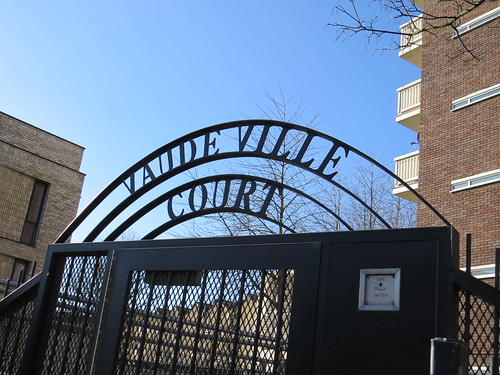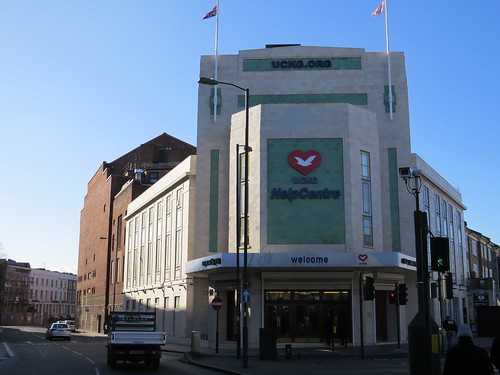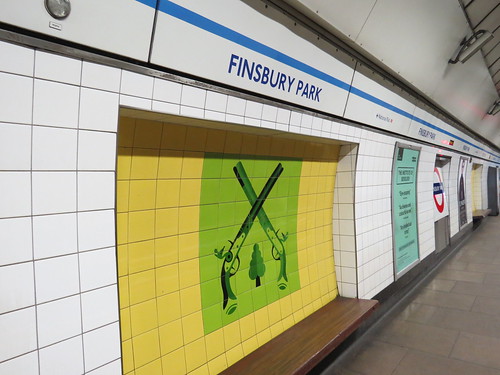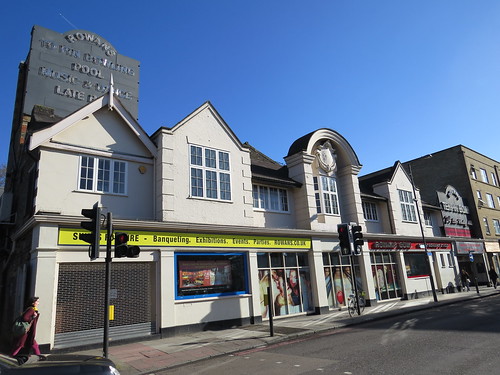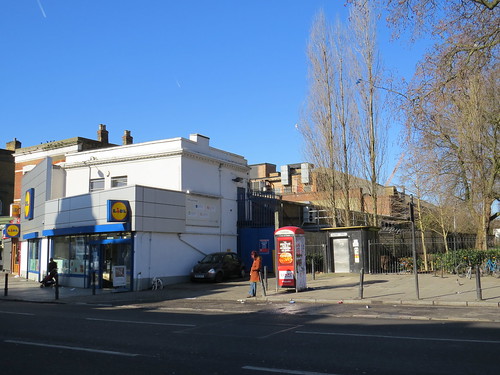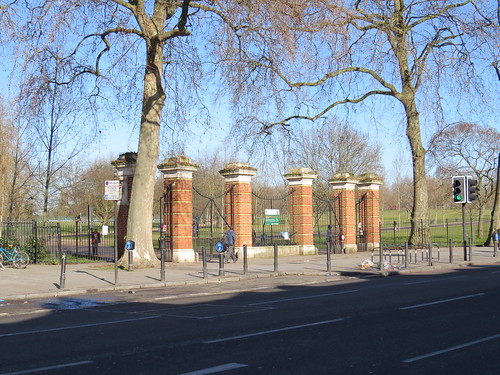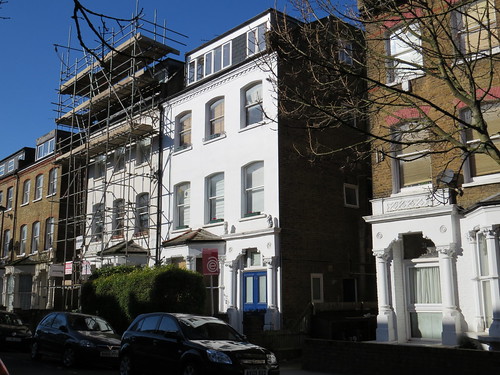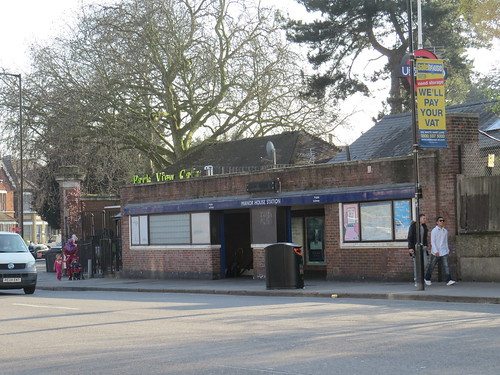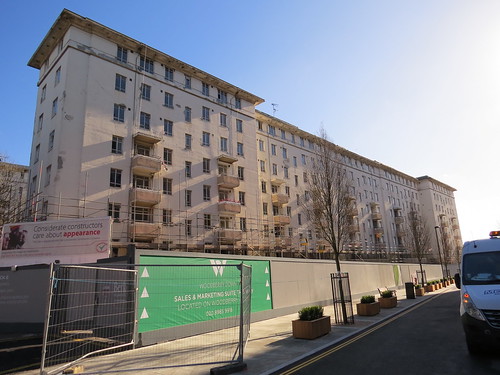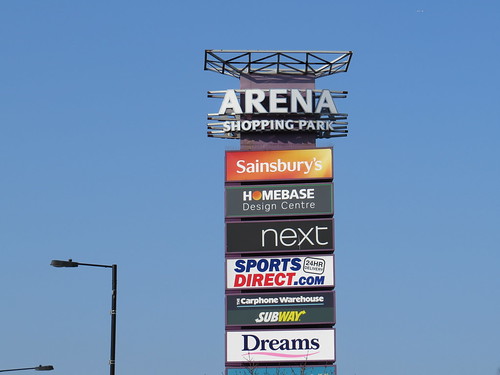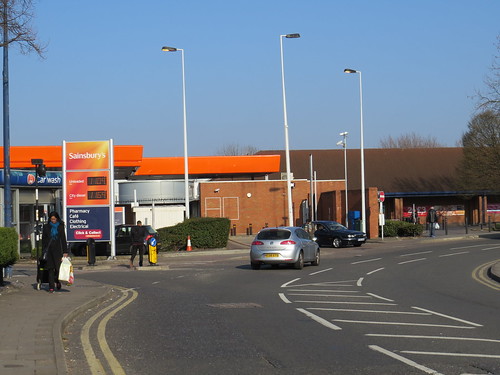N4 is Finsbury Park. This is a distinct and different place from Finsbury which is a couple of miles south on the northern border of the City. But there is a connection – and some confusion between the two – as we shall see.
We start our walk at the Post Office at 290 Seven Sisters Road.
Turn left out of the door and walk along Seven Sisters Road crossing Blackstock Road and then taking the first left.
Go down St Thomas’s Road and ahead as Prah Road goes off to the left you will see a block of flats, called Vaudeville Court.
Now with a name Vaudeville Court, you have to expect this site to have a theatrical link and indeed it does. This is the site of the Finsbury Park Empire.
The Finsbury Park Empire Theatre was opened on 5 September 1910 by the Moss Empires Theatres chain.
Designed by the prolific theatrical architect Frank Matcham, its exterior was similar to the 1903 vintage Shepherd’s Bush Empire Theatre (which we saw in W12) but the tower feature was on the right hand side of Finsbury Park, whereas at Shepherd’s Bush it was on the left hand side.
The Finsbury Park Empire Theatre was 2nd in line to Moss Empires top (or Number 1) theatre, the London Palladium Theatre. Shows came direct from the London Palladium to Finsbury Park before setting off on their nationwide tour of other Moss Empire theatres. Pretty much all the famous names played here, from Lily Langtree, Marie Lloyd and Houdini, though Sophie Tucker, W.C. Fields, Gracie Fields, The Crazy Gang, Laurel & Hardy, to Max Miller and Tony Hancock. In its final years, pop stars topped the bill, including Shirley Bassey, Alma Cogan, Marty Wilde and Cliff Richard.
The final show was on 7 May 1960. The interior and exterior of the closed theatre were used in early 1961 for the filming of “The Young Ones” which starred Cliff Richard. After this it became a scenery storage for the Stoll Moss chain. Islington Council compulsorily purchased the theatre in July 1964. It was demolished the following year and replaced by this boring block of flats.
With Prah Road behind you and Vaudeville Court on your left you will see ahead of you on St Thomas’s Road, our next stop.
Stop 2: Finsbury Park Mosque
The mosque first opened in 1988, but in the late 1990s it became a place synonymous with extreme views.
In 1996 they installed Abu Hamza al-Masri as imam of the mosque and from then it developed a reputation as a centre of radical Islamism in London. Abu Hamza al-Masri was eventually jailed for seven years in 2006 after being convicted of inciting murder and race hate.
Later, he was deported to the United States to face terrorism charges after a ten year battle in the British courts based on the European Convention on Human Rights. He was eventually sentenced to life in prison. The Daily Mirror report of this has a depressingly typical headline: “Hook-handed terrorist Abu Hamza al-Masri is GUILTY and faces 100 years in jail” http://www.mirror.co.uk/news/uk-news/hook-handed-terrorist-abu-hamza-al-masri-3572628
But this is very much in the past and a new board of trustees was installed and things have moved on since then. See this BBC report for the story: http://news.bbc.co.uk/1/hi/uk/4639074.stm
Head back to Seven Sisters Road and turn left going under the railway bridge. Our next stop is ahead at the junction with Isledon Road.
Stop 3: Former Astoria Cinema/Rainbow Theatre
Here is one of those wonderful survivals of a super cinema.
Opened as the Astoria in September 1930, it was part of a small chain of Astorias, of which we have already seen two – in SW9 Brixton and SW16 Streatham. Taken over by Paramount Pictures in December 1930, it became part of Oscar Deutsch’s Odeon chain in 1939.
Like many cinemas of this age it had full stage facilities and it was used for one off pop concerts in the 1960s. It remained a cinema as well until it was finally closed in 1971. It then had a new lease of life when it was rechristened “The Rainbow Theatre” in November 1971 and became a full time live music venue, which it remained, apart from the odd film showing, until its closure in December 1981. Practically every major act of the 1960s and 1970s performed here.
After languishing unused and unloved for some 14 years it was taken over by United Church of the Kingdom of God and they have restored it.
Today although the building houses a church it still has a little plate on the front which says “Rainbow Theatre”.
When I visited N4, it was open and I went in. There is a desk just as you go in and a very nice young man offered to show me round. (Sadly though I was not allowed to take photos)
The Finsbury park Astoria interior is quite something. You go in through a lobby with a little fountain and then along a wide corridor. The auditorium is quite a walk from the entrance (as you deduce from the picture of the front). Once inside the auditorium, my guide put the lights on to show it is decorated as if it were a small Spanish village. At one time there would have been twinkling lights in the ceiling to make you think you were under the stars in Spain.
The effect is somewhat spoiled by the fact that the stalls has been refitted with a white floor and shiny red seats. I guess one has to accept this is a working building and not a museum piece. But I was over the moon to get a look over the Rainbow.
Return along Seven Sisters Road and our next stop is on the left.
Stop 4 Finsbury Park Station
This is a curious station.
Upstairs there is a suburban national rail station. The line here was built in 1850 but the station was not added until 1862. Today this is the first station stop out from Kings Cross now but it was not originally. There were a couple of intermediate stations which were taken out when the Great Northern, Piccadilly and Brompton Railway opened in 1906 with its northern terminal beneath the main line station. The underground line in effect replaced the intermediate stations and so freed up capacity on the main line. This became the Piccadilly line which was extended north in the early 1930s, more of which anon.
But there was also an earlier underground station completed here by the Great Northern and City Railway (GN & CR) in 1904. The original plan was for the Great Northern Railway to electrify the suburban train route north of here and then run mainly in tunnel down to Moorgate, giving them a city terminal.
The scheme never got finished but the tunnels were built so as to take full size trains rather than tube size. The line was acquired by the Metropolitan Railway in 1913 and so in due course became part of the Underground. But for almost 60 years, trains just ran between Finsbury Park and Moorgate.
The two underground stations were side by side and quite close to the surface, so that no lifts or escalators were needed.
When the Victoria line came to be built, the lines were reconfigured so that the south bound Piccadilly line was diverted to the northbound GN & CR platform and the Victoria line was built so that its northbound platform was the old Piccadilly line southbound platform and its southbound platform was the old GN & CR southbound platform. And the line to and from Moorgate was rerouted upstairs so eventually fulfilled its original purpose in taking suburban services from the Great Northern lines.
Fascinating fact: the Victoria Line platforms have tiles with dueling pistols and the Piccadilly line ones have hot air balloons.
But this apparently is a case of mistaken identity as the duels and hot air balloons are connected with Finsbury Fields which was near Moorgate and the modern day Finsbury Circus.
For the full story of this station (including how this was to link with the Northern Heights project) – see Wikipedia entry: http://en.wikipedia.org/wiki/Finsbury_Park_station
Finsbury Park Station is about to get a major makeover, which will create a whole new ticket hall and step free access, as part of major housing development. But this is going to mean closing off of one entrance for over two years, so severe congestion is predicted.
Our next stop is one the other side of the railway (either go through the station tunnels or on Seven Sisters Road), then go into Station Place and ahead is our next stop on Stroud Green Road
Stop 5: Rowan’s Ten Pin Bowl, 10 Stroud Green Road
You can tell this building has a bit of history, but the story is a quite remarkable one of two buildings which became linked together and then separated again.
The building on Stroud Green Road started out as a depot for horse drawn trams. In 1909 it was converted into a roller skating rink, but the craze subsided before it could open, so it opened instead in October 1909 but with a striking lack of originality it was called the Rink Cinema. Initially seating was on one level, but a balcony was added in 1916 which gave a total seating capacity of 2,800.
Then just round the corner by the entrance to Finsbury Park itself at 269 Seven Sisters Road a certain Montague Pyke opened his Pyke’s Cinematograph Theatre on 2 October 1909. It was his second cinema (we have already seen his Shepherd’s Bush cinema in W12 and we saw the location of his Hammersmith one in W6). It closed as a cinema in 1915 but in 1920 the building was combined with the Rink cinema and the main entrance of the Rink cinema was moved to Seven Sisters Road.
It went through a couple of owners in the 1920s and ended up being owned by Gaumont in 1929. It continued to be called the Rink until it was renamed Gaumont in 1950, closing as a cinema in 1959. After a short spell as a dance hall it became a Bingo Hall in the early 1960s. Bingo ended in 1984 and at some point thereafter the two building went their separate ways.
The bit that had been the Pyke Cinematograph Theatre, and later the main entrance, became unused and was demolished in 1999. Nothing was built on this plot of land until around 2006, when a Netto supermarket was built. It is now Lidl.
The original Rink Cinema and later the main auditorium, became a snooker club. In the late 1990’s it was converted into a Ten Pin Bowl known as Rowan’s and this is what we see today.
If you go past Lidl you will see our next stop on the left.
Stop 6: Finsbury Park
Here we have one of the main entrances to Finsbury Park.
The park here was supposed to be a lot bigger. In around 1850, plans were drawn up for a park to stretch from Highbury in the south to the edge of Harringay in the north to be named Albert Park. By the time the park formally opened in August 1869, much of the land south of here had been developed so the final park was much smaller than originally envisaged. And instead of being called Albert Park it’s name was taken from the area where the benefactors who created it lived – ie the place where duels were fought and hot air balloons took off from.
Today Finsbury Park is much better known than Finsbury, which is no doubt why there was the confusion over the station tiles.
Walk alongside the park and turn right down Queens Drive taking the first left and then taking the left hand road (which is Adolophus Road)
Stop 7: Number 29 Adolphus Road
This unassuming house has its own little website:
http://www.29adolphusroad.co.uk/index.html
from which I learn it was built around 1879, and is now split into 7 flats. The first lessee was one Henry Adolphus Wickes who is believed to have built all the houses in this street and the surrounding streets. Indeed just around the corner is a Henry Road. How nice for a house to have its own website.
Continue walking along Adolphus Road to the end and turn left into Portland Rise. Turn right at the end (Seven Sisters Road) and continue to the cross roads where Green Lanes crosses Seven Sisters Road
Stop 8: Manor House Station
This was the first new station on the northern extension of the Piccadilly line opened in 1932 and designed by Charles Holden.
Unlike the other stations on this extension, it does not have much of a surface building and the main access is through subways.
Go down one of the subways and have a look at the ticket hall.
This has some lovely features and helpfully a good display of old photos and heritage information
One feature now lost was a subway link to tram stops which were in the middle of Seven Sisters Road north of the station.
Now back on the surface, notice the building on the far left hand corner of the junction.
Stop 9: former Manor House pub
This was once the Manor House pub which gave this area its name.
Now most of it is taken up with an independent looking organic supermarket. Well at least it is not Tesco or Sainsburys.
But there is a reminder of the pub on the side which shows it was rebuilt in 1931, so just before the tube arrived.
Go a short way up Seven Sisters Road and look at the building on the left.
Stop 10: former Tramway building
This sad looking building was the offices of the Metropolitan Electric Tramways (MET) and later became the Eastern Divisional Office of London Transport Buses. MET operated electric tram services in suburban areas of Middlesex and Hertfordshire from 1904 to 1933, when it was absorbed into the new London Passenger Transport Board.
You can see the MET logo into the terra cotta detailing of the building.
Now cross Seven Sisters Road and go down Woodberry Down.
Stop 11: Woodberry Down estate
You are now in the huge Woodberry Down estate. Planned by the London County Council in the 1930s, construction began in 1949 and by 1962, 57 blocks of flats had been completed.
As the properties became in need of expensive renovation , there is now a major – and quite controversial – redevelopment.
However it is difficult to see how Hackney Council could otherwise have redeveloped this estate given the restrictive Government policies on public housing finance.
For a more information have a look at this excellent article:
https://municipaldreams.wordpress.com/2013/09/17/woodberry-down-hackney-the-estate-of-the-future/
If you venture into the estate, you find it adjoins a couple of reservoirs on the New River.
And there are interesting views back towards the City.
We could end the walk here but there is one last place I would like to share with you in N4. Go back to Manor House tube and go right along Green Lanes beside the park
Our last stop is quite a trek, so you might want to hop on a 29 bus.
But if you do you might miss where we cross the New River (which is about halfway)
Our final stop is just before the railway bridge
Stop 12: site of Harringay Arena and Stadium
Today there is a retail park but once this was the location of two sporting venues: Harringay Arena and Harringay Stadium.
Harringay Stadium opened in 1927 and was built on the site of the Williamson’s Pottery Works which operated from the late 18th century through to the early 1900s. Later this land was used as a dumping ground for the spoil from the construction of the Piccadilly line extension.
The popularity of greyhound racing started to decline in the 1960s. The stadium received little investment and became run down. It was finally sold in 1985 to Sainsbury’s and two years later in September 1987 it closed down. The site was cleared and in its place a Sainsbury’s store and some new housing was built.
The Arena was adjoining the stadium but nearer Green Lanes. It opened in 1936 and lasted as a venue until 1958. It was a stark modernist octagonal-shaped building and could seat 10,000 people. It was used for ice hockey and also boxing when a removable floor could be laid over the ice.
There is not much to indicate its previous use but there is this intriguing terra cotta panel in the road by the McDonalds drive through facility
This has the motto “Progress through humanity”
Not sure if this has anything to do with the previous uses of the site.
Well this brings us to the end of the N4 walk. We have seen a couple of old cinemas, some interesting transport connections, a park and some housing.
You are now right by Harringay Green Lanes station. This is on the Gospel Oak – Barking line which is not that useful unless you want to go to Gospel Oak or Barking. But there are buses along Green Lane which will take you back to Manor House tube.

